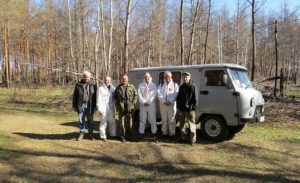Dr Wood (second from left) and Dr Entwistle (4th from left) with some of their ‘RED FIRE’ collaborators at the edge of the Red Forest
Award-winning researcher, Dr Mike Wood, is back in Chernobyl. This time he’s accompanied by fellow Salford academic, Dr Neil Entwistle, as they undertake fieldwork in Chernobyl’s ‘Red Forest’ for their latest NERC grant.
The Red Forest is the most anthropogenically contaminated radioactive ecosystem on earth. Located just a few kilometres from the Chernobyl Nuclear Power Plant where the 1986 accident occurred, this 4 – 6 square kilometres area of coniferous forest was killed by high radiation levels. Before the trees died, their needles turned a red/orange colour and the area was named the Red Forest. In the 30 years since the accident, the area has transitioned into a deciduous woodland (deciduous trees are more resistant to radiation than conifers).
A severe fire in the Red Forest during July 2016 was reported to have burnt approximately 80 percent of the forest. This presented a unique opportunity to study the effect of fire on i) radionuclide mobility/bioavailability and ii) the impact of radiation on the recovery of the forest ecosystems exposed to another stressor (ie. fire).
The new NERC grant, RED FIRE (Radioactive Environment Damaged by Fire: a Forest in Recovery), is funding an international research team to study the aftermath of the fire. Dr Wood and Dr Entwistle, both from the School of Environment & Life Sciences, are working in collaboration with the Centre for Ecology & Hydrology, University of Nottingham, Chornobyl Center, the Ukrainian Institute of Agricultural Radiology and the Norwegian University of Life Sciences.
The team are using a combination of techniques, from soil analysis to drones, to study the fire damages area. The project builds on Dr Wood’s previous radioecology research collaborations, including those developed through the NERC TREE project (www.ceh.ac.uk/TREE). Dr Entwistle, an expert in drone-based research, is a new and valuable addition to the research team due to his specialist expertise.
RED FIRE is led by Prof Nick Beresford at the Centre for Ecology & Hydrology. Initial findings from the project will be reported at the 4th International Conference on Radioecology and Environmental Radioactivity (ICRER) in Berlin in September 2017.
Mike will be doing a special Alumni Lecture in London on Thursday 25th May (6-8.30pm) at The Royal Institution, 21 Albemarle Street, W1S 4BS. In his lecture ‘Life in the shadow of Chernobyl’ he will take you on a journey through this environment, introduce you to some of the animals that live there and explain how his team’s findings are challenging some recent publications on the effects of radiation on Chernobyl wildlife.
